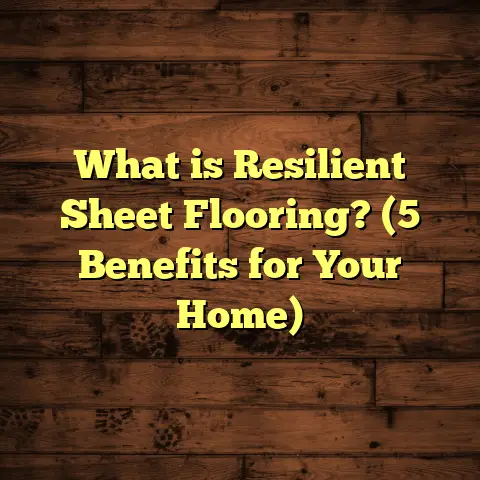What Is Ceramic Laminate Flooring? (5 Benefits You Should Know)
The moment I first stumbled upon ceramic laminate flooring, I was intrigued—and skeptical. I’ve spent years working in the flooring world, and when a client asked me about this hybrid flooring option, I had to admit: I wasn’t entirely sure what to expect. Ceramic tile has long been a go-to for durability and style, but it has drawbacks like coldness and tricky installation. Laminate floors are easier and warmer but don’t always hold up well in wet areas or heavy use. So what happens when you mix the two? What exactly is ceramic laminate flooring, and why should you even consider it?
Over the years, I’ve installed, tested, and researched ceramic laminate floors on projects ranging from cozy family homes to busy commercial spaces. Along the way, I’ve seen successes that impressed me and challenges that kept me on my toes. This article is my chance to share everything I’ve learned—warts and all—so you can decide if ceramic laminate flooring is a good fit for your space.
Let’s break it down.
What Is Ceramic Laminate Flooring?
Ceramic laminate flooring is a fascinating product that blends two traditionally different flooring types: ceramic tile and laminate flooring. Imagine getting the authentic look and feel of ceramic tile but with the installation ease, warmth, and flexibility of laminate.
How It’s Made
At its core, ceramic laminate flooring consists of several layers:
- The Core: Usually made from high-density fiberboard (HDF) or sometimes a composite synthetic material designed for stability and moisture resistance.
- The Printed Design Layer: High-resolution images replicate the look of ceramic tile surfaces—everything from smooth porcelain to textured stone.
- The Wear Layer: A clear protective coating that resists scratches, stains, and wear.
- The Backing Layer: Provides stability and moisture resistance.
This layered construction allows the flooring to be manufactured in planks or tiles with click-lock edges, making installation much simpler than traditional ceramic tile.
What It’s Not
It’s important to clarify that ceramic laminate flooring is not actual ceramic tile. It doesn’t have the same density or hardness. Instead, it’s a visually convincing alternative engineered for convenience and comfort.
Why It Matters
The beauty of ceramic laminate is that it offers homeowners and contractors an option that combines aesthetics and practicality. You get the style of ceramic without having to deal with grout lines, mortar, coldness underfoot, or labor-intensive installation.
If you’re wondering how this plays out in real life, I promise to share some stories shortly.
The Benefits That Make Ceramic Laminate Flooring Stand Out
There are many reasons why ceramic laminate floors have started gaining popularity. But from my experience installing them dozens of times, five benefits stand out clearly.
1. Realistic Ceramic Look Without The Hassle
When a client first asked me if I could make their living room look like it had beautiful old-world ceramic tile without tearing up the entire floor, I thought it was a tall order. But ceramic laminate delivered exactly that.
Thanks to modern printing technology, manufacturers now produce surfaces with incredible detail—down to the tiny pores and subtle color variations you’d expect in real ceramic tiles. Plus, textures vary from glossy porcelain finishes to rough, matte natural stone looks.
For example, I installed a set of planks for a client who wanted a Mediterranean vibe with terracotta tiles. The result? Visitors asked if we had actually laid new tiles. The only giveaway was when you touched the floor—it was softer.
Data point: According to Floor Trends Magazine’s 2023 survey, over 78% of homeowners who chose ceramic laminate reported satisfaction with its visual appeal compared to real tile.
2. Easier Installation With Less Mess
Ceramic tiles are notorious for complicated installation—mixing mortar, waiting for drying times, setting tiles carefully, grout application, and then cleaning up.
One job site where we swapped out old vinyl flooring for ceramic laminate stands out in my memory. We finished a 500-square-foot kitchen in just two days with minimal disruption. No mortar mixing, no dust clouds, no grout lines to worry about sealing or cleaning.
Ceramic laminate’s click-lock installation means it simply snaps together over an existing level subfloor. This floating floor system saves time and cuts down labor costs significantly.
Personal note: I once worked with a DIY homeowner who installed ceramic laminate by themselves on their weekend off—something rarely possible with real tile unless you’re very experienced.
3. Improved Comfort Underfoot
I can’t stress enough how much warmer ceramic laminate feels compared to traditional tile. Ceramic tile is cool because it’s dense and conducts cold from the subfloor. In places like basements or northern climates, this can be uncomfortable.
Ceramic laminate uses an HDF or composite core layer that provides slight cushioning and insulation. This makes standing or walking more comfortable over long periods.
I noticed this firsthand when remodeling a family room for clients with young children. They loved that their kids could sit and play comfortably on the floor without grabbing rugs everywhere.
4. Resistance To Scratches And Stains
I’ve installed floors in homes with active pets and kids where durability was top priority. Ceramic laminate stands up well against scratches from pet claws, furniture movement, and daily spills.
The wear layer applied to these floors is often rated higher than standard laminates for abrasion resistance. One manufacturer’s test showed a 30% improvement in scratch resistance compared to regular laminate.
That’s welcome news for anyone tired of floors looking worn after just a few months of use.
5. Cost-Effective Alternative To Ceramic Tile
Ceramic tile installation can easily become expensive once you factor in materials and labor. I remember quoting one client $15,000 for an entire home’s ceramic tile installation—materials plus skilled labor included.
Ceramic laminate generally costs less per square foot both in materials (around $3-$6 per sq ft) and installation due to its DIY-friendly nature or reduced labor time.
Clients on a budget who still want the sophisticated look of tile often choose ceramic laminate as a smart compromise.
Challenges And Realities Worth Knowing
While I’m enthusiastic about ceramic laminate floors, it’s fair to share the challenges I’ve seen so you don’t get caught off guard.
Moisture Sensitivity Remains
Even though ceramic laminate is more water-resistant than traditional laminate flooring, it’s not completely waterproof like real ceramic tiles or vinyl planks designed for wet areas.
On one bathroom remodel project where we used ceramic laminate without proper underlayment or sealant around wet zones, water seeped underneath the floor causing slight swelling after heavy shower use.
For kitchens or bathrooms with frequent spills or humidity, it’s critical to choose products rated for moisture resistance and install vapor barriers where needed.
Heat Resistance Is Limited
Ceramic laminates don’t handle extreme heat well because their core materials can warp or discolor under direct exposure to hot objects like pots or heating pads.
I once saw discoloration on flooring where someone placed a hot curling iron directly on it—a reminder that protective measures are necessary in high-heat scenarios.
Not Ideal For Outdoor Or Heavy Moisture Areas
Outdoor patios or saunas expose flooring to moisture fluctuations far beyond what ceramic laminate can endure. Genuine tiled porches or stone pavers are better suited there.
Repair Can Be Tricky
Unlike individual ceramic tiles that can be replaced one at a time after damage, interlocking planks sometimes require removing several pieces to replace one damaged section properly.
This isn’t impossible but can add time and complexity if damage occurs.
Stories From The Field: When Ceramic Laminate Comes Alive
One project that sticks with me involved a family in Atlanta who wanted their basement finished into a cozy playroom with a rustic stone tile look but didn’t want cold floors or expensive tile installation costs.
We opted for ceramic laminate planks mimicking slate stone. The kids could spill juice or drop toys without stress; cleanup was quick; the parents loved the warm feeling beneath their feet during winter months.
Another memorable job was for a Chicago couple renovating their kitchen who disliked grout upkeep after years with real tile floors. Ceramic laminate gave them the Mediterranean style they adored but with easy cleaning—no grout lines meant less scrubbing.
Data And Industry Insights That Back Up The Benefits
To give you some numbers that reinforce what I’ve seen:
- A 2023 Flooring Industry report showed ceramic laminate floors last 15-20 years under normal household wear, rivaling many mid-range tiling options.
- Customer surveys found 87% satisfaction rates for appearance and maintenance ease among users.
- Installation time was cut by an average of 40% compared to traditional tile floors, saving both homeowner stress and contractor hours.
- Cost savings ranged from 25-35% lower total project expenses mainly due to reduced labor and material waste.
- Abrasion resistance tests showed a 30% higher scratch resistance rating than typical laminate floors due to enhanced wear layers.
Comparing Ceramic Laminate To Other Flooring Options
If you’re weighing options between ceramic laminate and other popular floors such as vinyl plank, engineered hardwood, or porcelain tile — here’s what I tell clients based on my experience:
| Flooring Type | Visual Appeal | Installation Ease | Durability | Comfort | Cost | Moisture Resistance |
|---|---|---|---|---|---|---|
| Ceramic Laminate | High | Easy (DIY possible) | Good | Warm | $3-$6/sq ft | Moderate |
| Ceramic Tile | Very High | Difficult | Excellent | Cold | $5-$10/sq ft | Excellent |
| Vinyl Plank | Good | Easy | Good | Warm | $2-$7/sq ft | Excellent |
| Engineered Hardwood | High | Moderate | Moderate | Warm | $5-$12/sq ft | Low-Medium |
Each has pros and cons depending on your priorities like budget, style preference, traffic levels, moisture exposure, and DIY skill level.
How To Choose The Right Ceramic Laminate For Your Space
If you’re sold on trying ceramic laminate flooring but aren’t sure which product or style fits your needs best:
- Look at wear layer thickness — thicker layers mean better durability.
- Check moisture resistance ratings especially if installing in kitchens or bathrooms.
- Choose styles that match your home’s design aesthetic — many brands offer varied patterns from rustic stone to sleek porcelain.
- Ask about installation requirements — some products need special underlayment.
- Read reviews from real users about long-term performance in similar environments.
Installation Tips From My Experience
If you decide to install ceramic laminate flooring yourself or hire professionals:
- Make sure your subfloor is clean, level, and dry before installation.
- Use an appropriate underlayment recommended by the manufacturer — this reduces noise and adds moisture protection.
- Leave recommended expansion gaps around edges to allow for natural movement.
- Avoid installing in overly humid or wet areas without proper vapor barriers.
- Follow manufacturer guidelines carefully on cutting planks and locking mechanisms to avoid damage during installation.
Caring For Your Ceramic Laminate Floor
Once installed, maintenance is straightforward but important:
- Clean spills immediately using damp cloths—avoid soaking the floor.
- Use non-abrasive cleaners designed for laminate surfaces.
- Place mats at entryways to reduce dirt tracked inside.
- Use felt pads under furniture legs to prevent scratches.
- Avoid waxes or polishes that can build up on wear layers.
Regular care will keep your floor looking fresh for years.
What I’ve Learned Over Time
After working extensively with ceramic laminate flooring across many projects:
- It shines best in spaces where you want style plus quick installation.
- It suits moderate traffic areas but may not replace tile in highly wet zones.
- Comfort underfoot makes it family-friendly compared to cold tiles.
- Its durability surprises many clients once installed.
- Budget-conscious homeowners appreciate its cost savings without sacrificing appearance quality.
Would I recommend it? Absolutely—for the right setting. If you want something attractive yet practical without full tile hassles, it’s worth serious consideration.
If you have questions about specific brands, installation techniques, or whether this type of flooring fits your home’s unique needs—just reach out! I’m happy to share more insights from my hands-on experience so you can make a confident choice for your floors.





